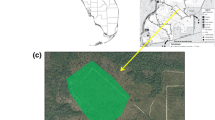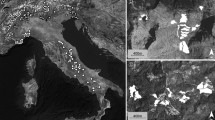Abstract
The distribution of the xerothermophilous Cinnabar moth Tyria jacobaeae was studied in a low mountain region in western Germany between 1989 and 2001. T. jacobaeae started its immigration into the study area in 1989 and first established populations in climatically favoured habitats like abandoned quarries and train stations where the larval host plant, ragwort (Senecio jacobaea), occurs. Analysis of landscape features (altitude, morphology) reveals that T. jacobaeae then dispersed along valleys with roads to higher altitudes of the study area. Elevations of occupied sites increased between 1989 and 2001. In order to investigate whether dispersal is affected by linear structures like valleys or roads with gravelled verges, hostplant exposures were placed at a distance of 600 m to the next population of T. jacobaeae. The experiments suggest that egglaying predominantly took place on exposures in valleys with roads and sparsely plant-covered verges but can also occur along valleys lacking roads and suitable habitats. However, larvae were never recorded on Senecio exposures which were placed aside from valleys and roads.
Similar content being viewed by others
References
Anderson G.S. and Danielson B.J. 1997. The effects of landscape composition and physiognomy on metapopulation size: the role of corridors. Landscape Ecology 12: 261–271.
Baguette M., Vansteenwegen C., Convi I. and Néve G. 1998. Sex-biased density-dependent migration in a metapopulation of the butterfly Proclossiana eunomia. Acta Oecologica 19: 17–24.
Browne D.R., Peles J.D. and Barrett G.W. 1999. Effects of landscape spatial structure on movement patterns of the hispid cotton rat (Sigmodon hispidus). Landscape Ecology 14: 53–65.
Brunzel S. 1996. Populationsökologische Untersuchungen am Schwalbenschwanz (Papilio machaon L. 1758). Z. Ökologie u. Naturschutz 5: 37–46.
Brunzel S. and Elligsen H. 1999. Change of species set and abundance along a short time gradient: The impact of weather conditions on the conservation of butterflies. Contributions to Entomology 49: 447–461.
Brunzel S. 2002. Inreased dispersal rates and distances in density-stressed bush crickets (Metrioptera brachyptera). Contributions to Entomology 52: 241–252.
Crowley M.J.R., Thomas C.D., Roy D.B., Wilson R.J., León-Cortés J.L., Gutiérrez D., Bulman C.R., Quinn R.M., Moss D. and Gaston K.J. 2001a. Density-distribution relationships in British butterflies. I. the effect of mobility and spatial scale. Journal of Animal Ecology 70: 410–425.
Crowley M.J.R., Thomas C.D., Wilson R.J., León-Cortés J.L., Gutiérrez D. and Bulman C.R. 2001b. Density-distribution relationships in British butterflies. II. An assessment of mechanisms. Journal of Animal Ecology 70: 426–441.
Dempster J.P. 1971. The Population Ecology of the Cinnabar Moth, Tyria jacobaeae L. (Lepidoptera, Arctiidae). Oecologia 7: 26–67.
Dempster J.P. 1997. The role of larval food resources and adult movement in the population-dynamics of the Orange-tip butterfly (Anthocharis cardamines). Oecologia 111: 549–556.
Ebert G. 1997. Die Schmetterlinge Baden-Württembergs Band 5: Nachtfalter III. Eugen Ulmer, Stuttgart, Germany. 575 pp.
Fahrig L. and Merriam G. 1985. Habitat and patch connectivity and population survival. Ecology 66: 1762–1768.
Gilpin M. and Hanski I. 1991. Metapopulation dynamics: brief history and conceptual domain. Biological Journal of the Linnean Society 42: 3–16.
Hanski I., and Thomas C.D. 1994. Metapopulation dynamics and conservation: a spatially explicit model applied to butterflies. Biological Conservation 68: 167–180.
Hanski I., Kuussaari M. and Nieminen M. 1994. Metapopulation structure and migration in the butterfly Melitaea cinxia. Ecology 73: 747–762.
Hansson L. 1991. Dispersal and connectivity in metapopulations. Biological Journal of the Linnean Society 42: 89–103.
Kindvall O. 1999. Dispersal in a metapopulation of the bush cricket. Metrioptera bicolor (Orthoptera: Tettigoniidae). Journal of Animal Ecology 68: 172–185.
Lederhouse R.C. 1982. Territorial defence and lek behaviour of the Black Swallowtail butterfly, Papilio polyxenes. Behavioral Ecology and Sociobiology 10: 109–118.
Mousson L., Nève G. and Baguette M. 1999. Metapopulation structure and conservation of the Cranberry Fritillary Boloria aquilonaris (Lepidoptera, Nymphalidae) in Belgium. Biological Conservation 87: 285–293.
Munguira M.L. and Thomas J.A. 1992. Use of road verges by butterfly and burnet populations, and the effect of roads on adult dispersal and mortality. Journal of Applied Ecology 29: 316–329.
Petit S., Moilanen A., Hanski I. and Baguette M. 2001. Metapopulation dynamics of the bog fritillary butterfly: movements between habitat patches. Oikos 92: 491–500.
Sutcliffe O.L. and Thomas C.D. 1996. Open corridors appear to facilitate dispersal by Ringlet butterflies (Aphantopus hyperantus) between woodland clearings. Conservation Biology 10: 1359–1365.
Sutcliffe O.L., Thomas C.D. and Peggie D. 1997. Area-dependent migration by Ringlet butterflies generates a mixture of patchy population and metapopulation attributes. Oecologia 109: 229–234.
Thomas C.D., Bodsworth e.J., Wilson R.J., Simmons A.D., Davies Z.G., Musche M. and Conradt L. 2001. Ecological and evolutionary processes at expanding range margins. Nature 411: 577–581.
Roy D.B., Rothery P., Moss D., Pollard E. and Thomas J.A. 2001. Butterfly numbers and weather: predicting historical trends in abundance and the future effects of climate change. Journal of Animal Ecology 70: 201–217.
van der Meijden E. 1976. Changes in distribution pattern of Tyria jacobaeae during the larval period. Netherlands Journal of Zoology 26: 136–161.
van der Meijden E. 1979. Herbivore exploitation of a fugitive plant species: local survival and extinction of the cinnabar moth and ragwort in a heterogenous environment. Oecologia 42: 307–323.
van der Meijden E., Van Wijk C.A.M. and Kooi R.E. 1991. Population dynamics of the cinnabar moth (Tyria jacobaeae): oscillations due to food limitation and local extinction risks. Netherlands Journal of Zoology 41: 158–173.
Warren M.S., Hill J.K., Thomas J.A., Asher J., Fox R., Huntley B., Roy D.B., Telfer M.G., Jeffcoate S., Harding P., Jeffcoate G., Willis S.G., Greatorex-Davis J.N., Moss D. and Thomas C.D. 2001. Rapid responses of British butterflies to opposing forces of climate and habitat change. Nature 414: 65–69.
With K.A., Gardner R.H. and Turner M.G. 1997. Landscape connectivity and population distribution in heterogenous environments. Oikos 78: 151–169.
Author information
Authors and Affiliations
Corresponding author
Rights and permissions
About this article
Cite this article
Brunzel, S., Elligsen, H. & Frankl, R. Distribution of the Cinnabar moth Tyria jacobaeae L. at landscape scale: use of linear landscape structures in egg laying on larval hostplant exposures. Landscape Ecol 19, 21–27 (2004). https://doi.org/10.1023/B:LAND.0000018354.77405.0e
Issue Date:
DOI: https://doi.org/10.1023/B:LAND.0000018354.77405.0e




